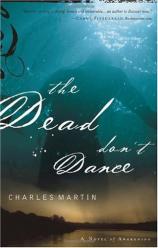The Dead Don't Dance: A Novel of Awakening
Review
The Dead Don't Dance: A Novel of Awakening
Dylan and Maggie Stiles have a marriage that seems nearly symbiotic; when she taps him on the shoulder for a midnight swim (and some connubial bliss), they conceive a son. The couple, living on the Stiles farm, couldn't be happier. Nothing is missing.
Or so they might think (although, as the novel makes clear, Maggie knows better all along). But when tragedy strikes (their baby boy is stillborn and Maggie lapses into a postnatal coma), Dylan finds himself alone in a desert. At first he is unwilling to accept the kindness of strangers, but soon he finds that kindness ---- from strangers and friends alike --- is all he has for the moment.
Slowly Dylan begins to fashion a post-childbirth life: his friend Amos, the town sheriff, convinces him to take a proffered job at the local community college teaching English 101. (Amos is African-American and Dylan is Caucasian; they've evidently been known as "Ebony and Ivory" for decades). Dylan, the taste of his doctoral training still sour in his mouth, balks at leaving his comfortable farming existence, but Amos shows him that it was Maggie herself who knew that Dylan needed more than plowing, tilling and harvesting in his life.
Characters as specifically drawn as Maggie (with her firm devotion), Amos and the utterly singular Bryce Kai MacGregor make this soft-spoken debut novel a must-read. MacGregor is a bagpipe-wielding, beer-swilling, trailer-inhabiting layabout with a heart bigger than his enormous trust fund. And the bookended characters of Amanda and Koy, both Dylan's students and both faced with similar burdens, offer a perspective on single motherhood not often found in Christian literature, yet at the same time not in conflict with the aims of that literature. Meanwhile, Dylan finds that teaching again both sparks his interest and kindles problems, since his students' reasons for taking composition are as varied as their ethnic backgrounds.
In the slow weeks that follow Maggie's confinement, Dylan finds that, like his diverse classroom, people have different ways of showing him hope: Amos takes him fishing, while Amanda invites him to her church. In a run-of-the-mill Christian novel, that invitation might be the dénouement of the book --- but Martin's own literary training (he has a Ph.D. from Regents University) serves him well. He presents Dylan's acceptance of Jesus Christ as one step in his spiritual pilgrimage --- the most important step, but not the only step, not the final step.
Thus, the actual dénouement does not seem as pat as it might in the hands of a lesser writer. Although it takes a second tragedy to open Dylan's eyes and heart to grace, these events happen fluidly, not awkwardly. One can easily imagine reading more about Dylan Stiles, and yet the best thing about THE DEAD DON'T DANCE is that you don't need to read more about Dylan Stiles. His story and Maggie's has been told, and told well. In subsequent novels, Martin will no doubt find that his talent for creating vivid characters means that he can allow them, rather than dramatic events, to bring meaning to his words.
Reviewed by Bethanne Kelly Patrick on January 7, 2011
The Dead Don't Dance: A Novel of Awakening
- Publication Date: May 12, 2004
- Genres: Fiction
- Paperback: 320 pages
- Publisher: Thomas Nelson
- ISBN-10: 0785261818
- ISBN-13: 9780785261810










